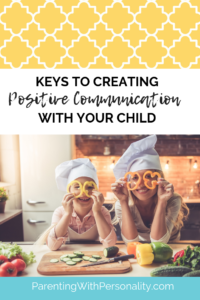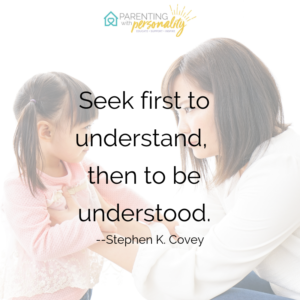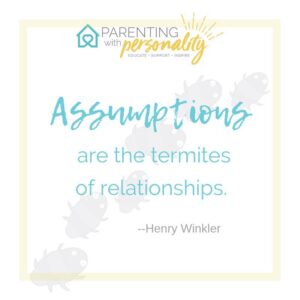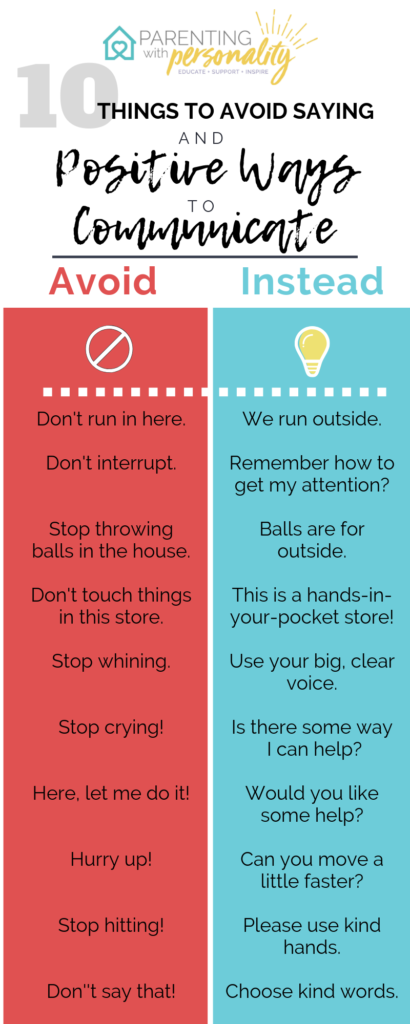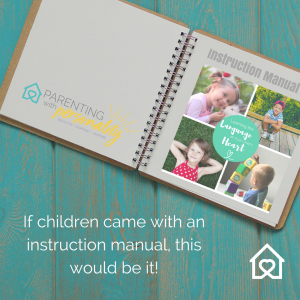Communicating is one of the simplest ways we interact with our family members each day. Yet for some reason, it can be one of the toughest to keep positive. It takes some careful focus and specific choices to keep things in a healthy and happy place. Parents, and especially moms, are key to setting the tone. So let’s talk about five simple little tips to create positive communication with our kids. No matter if your child is a toddler or teen, these will be useful in how you work to build a positive relationship with them. Now it can be tempting to think that communication is all about talking, but let’s not forget that the largest component of our communication is actually non-verbal communication (the body language, tone of voice, etc.).
You can find studies that suggest that anywhere from 60-90% of communication is nonverbal. There is some discrepancy between researchers and research methods to account for the large range, but regardless, we can agree that non-verbals are quite significant. So it is most effective to consider verbal and non-verbal together.
Have you ever found yourself in one of these situations?
You are dealing with your preschool child and it seems as though you face one meltdown or fit upon another. You are wearing out and you don’t feel very effective with discipline. Despite your efforts to have a positive day with your child, you feel incredibly frustrated. So, when you hand them a cheeseburger and they meltdown because they wanted chicken nuggets, you think you might lose your mind.
You are encouraging your school-aged child to dress, but he is lingering and frustrated with your choice of clothing. You just bought the clothes, and they are special for the occasion. However, in this moment, you hear words that sound ungrateful, mean, and attacking. In the midst of the complaining you hear from your child, you think you might pull your hair out.
You are talking through the weekend plans, and your teenager decides to spring a last-minute plan upon you. He desperately wants to go to the neighboring town’s basketball game. He has had a steady stream of social outings lately and very little home time with family. In the moment, you feel a little like screaming, with the number of activities your family is attempting to juggle. As he becomes insistent and moody, you think you’ve hit the end of your rope.
In each of these situations, communication is vital to the relationship you foster between you and your child. And in each of these scenarios, good communication may not come easy! But it will be well worth your efforts.
So how does one navigate such situations with healthy and positive communication in mind? Let’s take a look at those five easy tips and see if it helps as we choose our course.
-
Hear the feelings and not just the words.
Whether dealing with meltdowns, fits, or arguing, it can be tempting to take kids words and run with them. I have to remind myself quite often to slow down and hear the feelings and not just the words being spoken. So, for example, the preschooler that is having a melt down about the nuggets. You might slow yourself down to hear disappointment in what they chose, frustration if it wasn’t what they pictured, or upset that somehow a pickle made its way into their cheeseburger. In the situation with the school-aged child, you might hear their worry that they might not like the feel or look of the clothing, frustration that they must dress up, or sadness that they don’t get to wear their favorite jersey instead. With the teenager, you might hear their embarrassment that they might have to tell their friends no, their fear that they are missing out on things, and their anger that you won’t change your rules.
Now trust me, these feelings are not always easily spelled out or spoken. In fact, quite the contrary! That is why the next two keys are important.
-
Utilize the powerful pause and assess the situation.
Because their feelings may not match their words, you might have to stop and ponder what is really going on. You might need to think, “What is behind this?” Ask yourself about those basic things that may have your child on a difficult course. Are they tired, needing food, feeling unsafe, struggling to find their etc. Sometimes when those basic needs are surfacing, we may struggle to communicate at all with our child. Is that preschool child needing some food, and especially protein (a common culprit of the fits and meltdowns)? Is that school-aged child experiencing something with sensory sensitivities or overstimulation? Is that teen-aged child operating on little sleep and needing to be approached at a better time?
It might be that there are other more complicated issues that you might need to understand. Could it be that they are struggling to find their “social footing,” hitting developmental independence, or that they are experiencing hormonal changes?
[clickandtweet handle=”” hashtag=”” related=”” layout=”” position=””]Taking time to pause will not only help you effectively evaluate what you are hearing and dealing with, but it will also help you choose your path.[/clickandtweet]Which leads to the next key.
-
Monitor your nonverbals.
We can be a master at picking up the nonverbals in our children. In fact, we can spot rolling of eyes with that magic set of eyes behind our head. And we quickly detect that little snippy tone or stomp in the step the first second they turn and head to their room. But are we as keen at picking up our own nonverbals that might cause our communication to go awry? Perhaps we flash a stern look that is less than loving, speak with a tone that causes them to feel less than secure, or pull out that pointer finger to emphasize our point when it really isn’t necessary. (Oh, how I hate when I slip and remember that as I pull out that index finger! Oooops!)
As silly as this one sounds, I find that it can actually be a challenge to keep in check. Just the other day, I was reminded by my teen that my voice when repeating what he had just said sounded as though I was mocking him. At first, I disagreed, but when I thought about it and reversed the roles, I realized that if he had used the same tone with repeating my words, I too would have felt that he was mocking. It was a bit embarrassing to admit my wrong, but it was necessary. I vowed to be more aware of that, as I do think that when I replay other’s words, I tend to change my tone to “fit” how it feels they said it. Problem is, it does not feel accurate to them and instead feels disrespectful.
Parenting can be a humbling journey of self-discovery. Yikes! A shake of the head can come across dismissive. A raise of the brow might be judgmental. That hand on your hip can come across condescending. And these are just a few examples. Don’t underestimate the value of your non-verbal communication.
-
Choose words that will enhance the relationship.
Sometimes we offer words of support for what is being felt. Other times we offer reassurance but redirection. And at times, we might have to correct or train. The words we choose are very important. They can bridge a gap between you and your child or drive a wedge between you. They can be the difference in connecting with their heart or fracturing a relationship.
You might consider doing away with such words as “always” and “never.” Not just with our kids, but with anyone in general, these words tend to cause the listener to stop listening. Quickly they can decide you are not being truthful or just exaggerating, and your point is lost. Totally lost. No matter how right you might be.
Another thing to keep in mind is to ask questions to seek information. Don’t just make assumptions. It is startling how often you might be saying the same thing but just hearing each other wrong. When you have gathered accurate information, take the time to address the things that matter. What are they feeling, desiring, hoping, or experiencing?
If they are wanting something, decide if there is a way you might accommodate in an appropriate time or way. If they are struggling with feelings, you can offer some ideas, or if they choose, help arrive at a solution. If they are angry, we might be able to lessen the emotion by acknowledging that. When we listen carefully, we can better respond to those things that are being said as well as those things that might not be said. And don’t be afraid to clarify. Then you can have a clearer idea of what is going on and what kind of communication is truly necessary.
-
Keep it positive.
Maybe you’ve heard the statistic before, but they say that kids need to hear 7 positive things for each negative thing they hear. That is incredible. That means if you correct your son or daughter about a negative attitude, you should be prepared at some point to note seven things that offer genuine praise or encouragement in their day. That can be tough. Which is another reason living in a positive state is so important. Then a positive perspective becomes our habit, rather than a challenge.
One simple way that we can keep things positive is in the way we frame our requests or instructions. This is one simple way we can begin to make things more positive between parent and child. You might need some ideas or inspiration, which is why I created this helpful infographic for communicating with your younger children. I wouldn’t recommend this with the teen scene! You might get some good laughs though! Feel free to pin this helpful resource for future reference.
The Simplest Things Have The Most Impact
Even just the simple ways we communicate with our kids, the requests we make or the way we correct them, can be both positive or negative. Hopefully, these ideas of things to avoid and ideas for ways to say it instead can motivate you to take a look at the way you are speaking. You might see some small ways you are communicating in a negative manner, without even intending to. Then you can make little changes for the positive.
Another simple way we can do this is in remembering the small things. A simple little please or thank you, well-timed apology or reassurance…all of these can convey our respect for our kids. They not only learn from our example, but also get a feeling that they will want to pass along to others. We can breed this kind of respect in our homes in the small ways.
Think of a time you did a task and you were kind of hoping someone would notice. How did it feel to realize that it wasn’t acknowledged or appreciated, but rather just expected? I am guessing it didn’t feel very good. I think of making dinner some time. If each person came to the table, ate without remark, took their dishes to the sink and carried on, I would feel a little frustrated or overlooked. Likewise, our kids can feel this same way when we see their behavior as something we just expect and don’t take time to appreciate or acknowledge. When was the last time you thanked your child for doing their chores to help the family? Maybe reframe that, as you would want or appreciate a thank you or positive comment about a meal?! Just a simple little motivator I use for myself!
Respect
So often our communication comes down to respect. When we love someone, we extend a respect for them. We value them and want to treat them in ways that honor them. And this is a character trait we work so hard at in parenting. You might enjoy this discussion starter about respect. Get your free download and opportunity to access the free parenting resource library here.
June is Effective Communication Month. Maybe this month we can focus on improving that communication that we help set the tone for. Then let’s carry those positive skills into the coming months, putting them to good use, and helping our family grow in the process.
Let’s Do This!
P.S. For more great resources stay tuned for more next week and please also revisit these past blog posts:
50 Words Every Child Needs to Hear
A Whole New Perspective on Discipline
Motivating Your Child Without Meltdowns and Mayhem
(Remember to grab the resources that come with those blog posts as well in the member’s only free resources. It is free to sign up and you can unsubscribe at any time, but you probably will find that you don’t want to miss out on any of the upcoming resources, live on the internet programs, and more!)
And don’t forget! One of the key ways to communicate with your child is to fully understand their personality. You see, each personality has some strengths and some struggles. Understanding what motivates them and what things may be more challenging to them gives us a great leg up in the journey! So be sure to check it out at my ‘Learn‘ page!
Also, you can start your Parenting Planner at any time, as it is un-dated and use the pages again next year and compare as you grow as a family! Download it free in your resources. If you would the Ultimate Journaling Parenting Planner (it also has un-dated month pages) to help keep track of everything and create a lasting memento to look back on in the future, check out the link in the sidebar, it is still available for a limited time!

